|
Marcel Duchamp's submission: Pocket Chess Set
with Rubber Glove
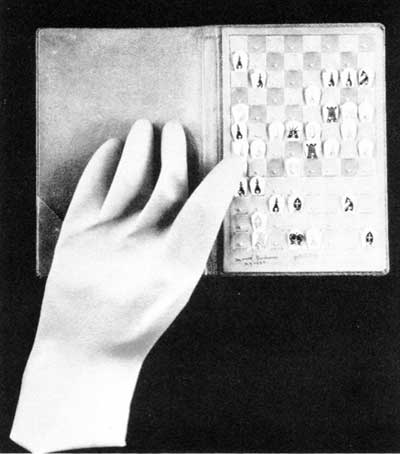
Pocket Chess Set, 1943
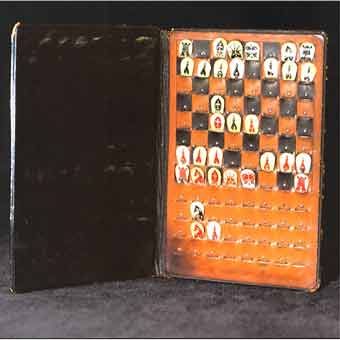
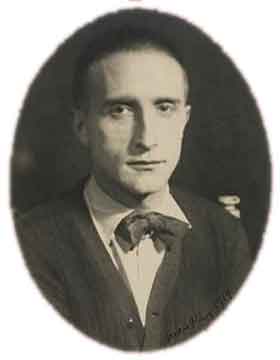
Marcel Duchamp
by Man Ray, 1919
"I am still a victim of chess. It has all the
beauty of art - and much more. It cannot be commercialized.
Chess is much purer than art in its social position." - Marcel Duchamp
Ever since Duchamp took up chess seriously, around
1923, he encouraged artists to produce chess sets. Originally, his purpose was
purely aesthetical. Later in life, he was still pushing this agenda, though even
more insistently, but for a different purpose - profit. The profit wasn't
personal. All proceeds went to the American Chess Foundation to subsidize
American players in international competitions. He wrote to Man Ray: "Je suis
dans le chess business maintenant... [Je suis un] missionaire en
quête de l'argent pour les échecs." Duchamp obtained chess-set donations
from Max Ernst, Alexander Caulder, Salvidor Dalí, Arman Fernandez and Man Ray.
As Neil Baldwin wrote in his masterpiece, Man Ray: American Artist
And what always remained astonishing about Duchamp
as a celebrity was that he did not promote himself. He simply glided along,
doing his work, making money when he needed it through various humble jobs.
People gravitated to Duchamp and became addicted to his presence. Men were
attracted to his refinement and impeccable politeness. Women found him alluring.
He was simply one of the kindest people anyone had ever known, completely
lacking in malice or rancor.
Man Ray wrote to Duchamp,
The most insignificant thing you do is a thousand
times more interesting than the best that can be said or done by your
detractors.
Duchamp was involved in chess from an early age.
His older brothers, in the paintings below, were chess players.
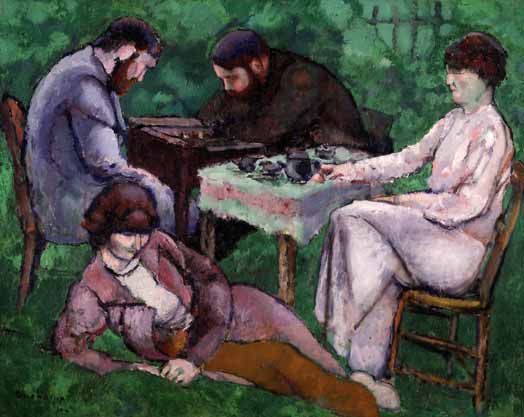
"A Game of
Chess" Marcel Duchamp, 1910
became
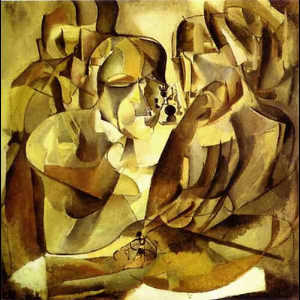
"Portrait
de joueurs d'échecs" Marcel Duchamp,
1911
In 1919, Duchamp took a trip to Buenos
Aires where his sister lived. When he returned he devoted himself to raising his
level of play to it's highest level. But during the trip to South America, he
designed a chess set about which there's been some debate. The commonly accepted
idea is that he made the set himself except for the Knight, which he hired a
local craftsman to carve by hand. Almost all authoritative books on Duchamp
mention this. However, Larry List, who documented the Imagery of Chess
Revisited show in 2003, argued quite convincingly that all the pieces but
the Knight were obviously turned on a lathe. While Duchamp created machine and
kinetic art, he never used machines to create the art. As a matter of fact,
Duchamp liked to create with his hands. While in Buenos Aires, he carved a set
of stamps for illustrating chess positions in correspondence games. List
suggests, even insists, that Duchamp hired a local to turn the pieces on a
lathe, while he himself carved the Knight by hand.
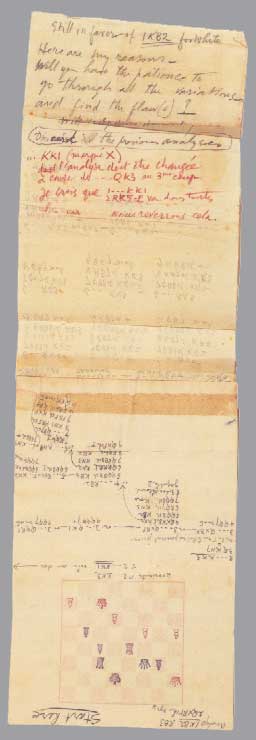 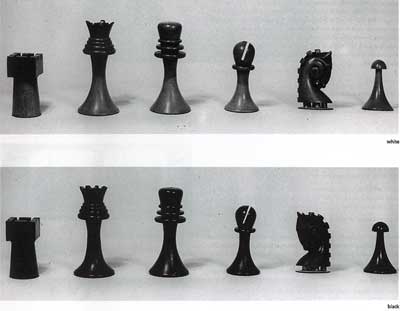
Duchamp's chess set
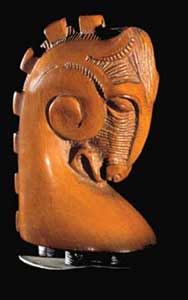
Duchamp's White Knight
chess notation Duchamp sent to Julien Levy using
his hand-carved stamps.
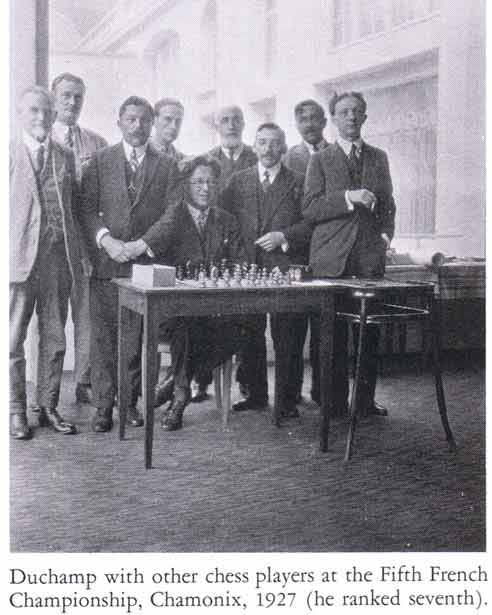
Duchamp is 4th from
left, standing in the background
A partial list of Duchamp's chess
involvement would look like:
French Championship at Nice, 1925
French Championship at Chamonix, 1927
Championship of Paris, 1927
1928 Chess Olympiad at The Hague
French Championship at Paris, 1928
Paris Team Cup, 1929
International Master Tournament, Paris, 1929
International Tournament, Nice 1930
International Tournament, Paris 1930
1930 Chess Olympiad at Hamburg
1933 5th Chess Olympiad at Folkstone
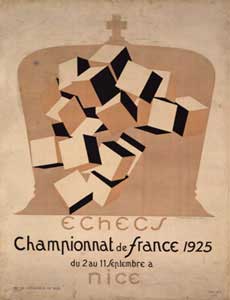
He designed the poster for the 1925 French
Championship, played in Nice.
For an amazingly detailed analysis of this poster
see:
Examining Evidence: Did Duchamp simply use a
photograph
of "tossed cubes" to create his 1925 Chess Poster?
by Shearer, Rhonda Roland and Slawinski, Robert
or read about Duchamp's
Color-coded Chromatic Chess
by Francis M. Naumann
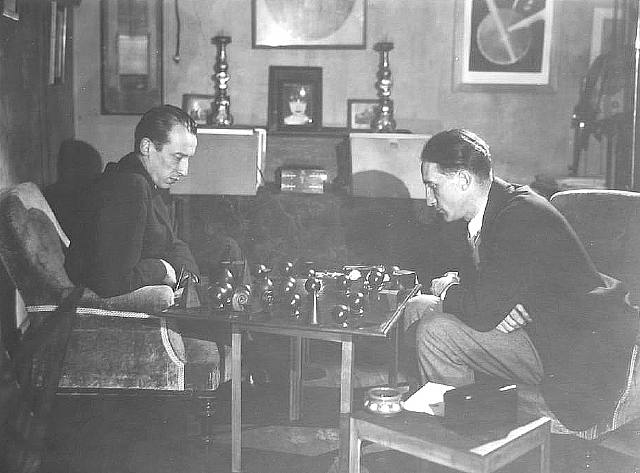
Marcel Duchamp and Comte Raoul de Roussy de
Sales playing chess, 1924 by Man Ray
Comte Raoul de Roussy de Sales (1896-1942) was a
French journalist who came to the United States to cover the New Deal for the
Revue de Paris. He also contributed to Paris-Soir, Paris-Midi,
L'Europe Nouvelle and the Havas News Agency. His writings were considered
very insightful, yet caustic.
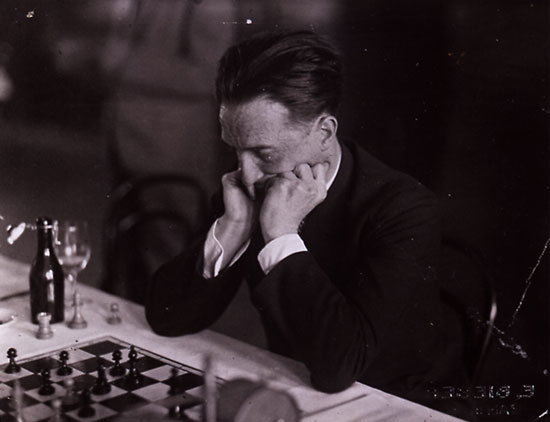
Marcel Duchamp, circa 1930
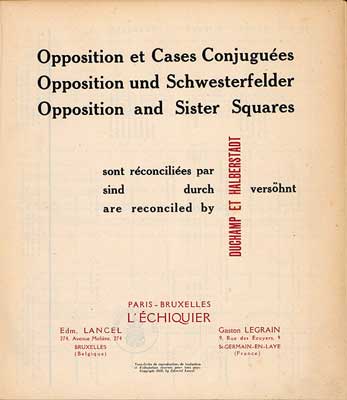
This book, entitled, L'Opposition
et Cases Conjugees sont Reconciliées (Opposition and Sister Squares are
Reconciled) Published by L'Echiquier, Edmond Lancel, Brussels, 1932,
Duchamp co-authored with the Ukrainian born problemist, endgame theorist and
Paris Champion of 1925, Vitaly Halberstadt (1903-1967)
It deals with one rare and
particular incident of opposition in a reciprocal zugzwang, called a
trébuchet.
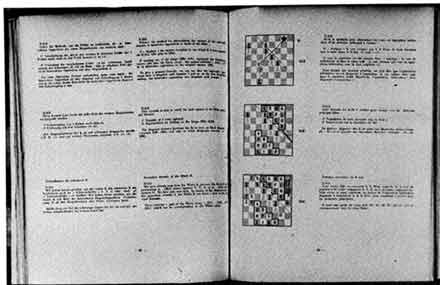
"His
competitive play in Hyères, Paris, The Hague, Marseilles, Nice, Hamburg,
Prague, La Baule and Folkestone occasionally resulted in what were, to
Duchamp, gratuitous victories. In 1930, he played to a draw with the American
champion, Frank Marshall, and in 1932, he won the Paris chess competition. But
Duchamp always insisted that winning was not the point. He wanted to get away
from winning so that he could comprehend chess in the same way he had gotten
away from painting, so that he would not fall into the trap of becoming an
addict to the smell of turpentine. To be seduced by the act of art was
tantamount to losing one's ability to comment intelligently about it." - Neil
Baldwin, Man Ray, American Artist
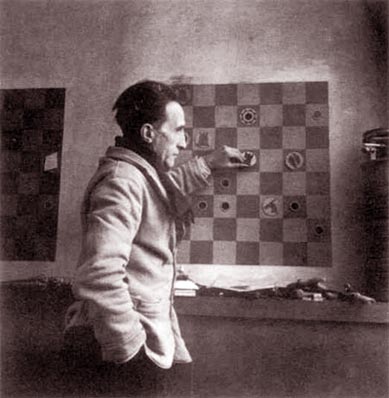
Duchamp, 1950
In
Folkestone, England, where Duchamp played in his last major event, they are
commemorating Marcel Duchamp with a project called,
Zugzwang.
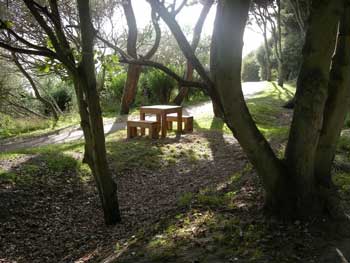
"The
project in Folkestone was a series of six tables and twelve benches to
commemorate that it was here that Marcel Duchamp played his last major chess
tournament, the 1933 Chess Olympiad. Each table represents one game he played;
upon each top are three etched stainless steel plates:one for Duchamp and one
for his opponent, on which their respective chess moves are displayed in chess
notation; and a chess board upon which is etched the final position of the
pieces at the end of the game. (Duchamp lost most of the games, which is
perhaps why it was his last major tournament.) It's almost an inversion of a
readymade. They were 'specially-mades' which strive for invisibility, rather
than a readymade that becomes newly visible." - source
Notes:
the following comes from the
book:
Marcel Duchamp: Appearance Stripped Bare By Octavio Paz (Translated by
Donald Gardner) 1990. Arcade Publishing
This is the chess content from the book which is almost in outline form, and
one page (and set of dates) is missing.
When the United
States enters the was, he moves to Buenos Aires where he continues his
creative activity for nine months...Plays chess avidly, and designs set of
rubber stamps to record games and to permit him to play chess by mail. Deeply
distressed by the death of Raymond Duchamp-Villon [his brother] in France on
October 9...makes plans to return to France.
1919 - joins chess club in Buenos Aires and plays constantly, to the point
where he refers to himself as a "chess maniac...."
1920 - Joins the Marshall Chess Club, New York....
1923 - Travels to Brussels in March, where he spends several months, during
which he participates in his first major chess tournament. His passion for
chess involves serious training and professional competition, which absorb
increasing amounts of time for about the next ten years....
1925 - participates in chess tournament, Nice, for which he designs poster.
1931 Important chess tournament in Prague. Becomes member of Committee of
French Federation and its delgate (until 1937) to the International Chess
Federation.
1932 With Vitaly Halberstadt, publishes L'Opposition et les cases conugées
sont réconciliées. Layout and cover by Duchamp.
Chess tournament at La Baule. Plays in radio match against Argentine Chess
Club of Buenos Aires. Wins Paris Chess Tournament in August, a high point in
his chess career.
About this time sees Raymond Roussel playing chess at nearby table at the Café
de la Régence, Paris, but they do not meet...
1933 - Last important international chess tournament, at Folkestone, England.
Translates Eugene Znosko-Borovsky's chess book into French.: Comment it
fait commencer une partie d'échecs, a study of opening moves that neatly
counters his own interest in end games.
1935- Serves as captain of French team of First International Chess by
Correspondence Olympiad. He is undefeated.
1937- Writes a chess column every Thursday for Paris daily journal Ce Soir,
edited by Louis Aragon.
from Marcel Duchamp in
Perspective By Joseph Masheck. 2002. Da Capo Press.
Like Leonardo,
Duchamp had always been more interested in the process of structuring a work
of art than in the final execution and ultimate result. Chess seemed to make
possible a constant renewal of this process ("the game itself is very, very
plastic"), involving a combination of mathematics and space, logic and
imagination, in which the end result is zero in the sense that the board is
swept clean. Thus, as a form of mathematic-esthetic speculation, chess playing
recapitulated Duchamp's renunciation of painting and summarized the Dada
belief that the value of creative activity lies in the process, in the act of
making, rather than in the esthetic significance of the thing made.
|

